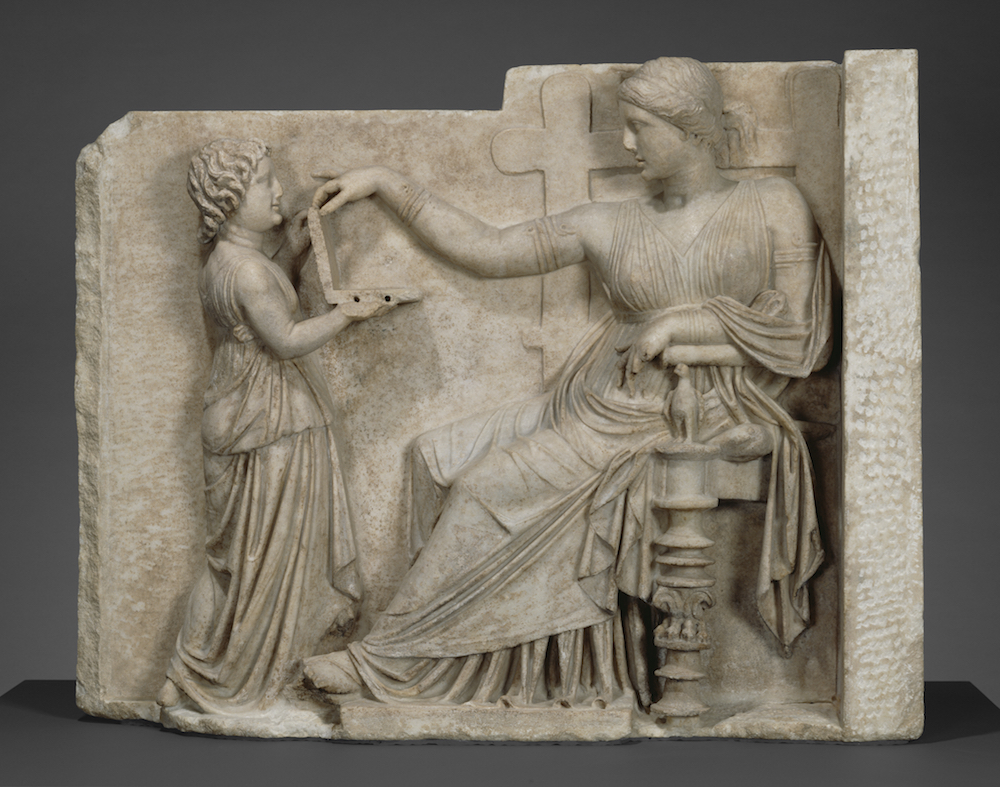Seriously? That Ancient Greek Statue Does Not Depict a Laptop

There's a new conspiracy theory out there, but instead of invoking big government or aliens, it questions whether there's a laptop carved into an ancient Greek statue.
That's right — there's a theory out there saying that a funerary statue of a woman, dated to about 100 B.C., shows her looking at a modern laptop or a handheld digital device. The theory, proposed by the anonymous YouTube user StillSpeakingOut, ventures that the ancient Oracle of Delphi may have foreseen the invention of laptops, and told people about it.
"Just so we are clear, I'm not saying that this relief was depicting an ancient laptop computer," StillSpeakingOut said in the 100-second-long video. [Supernatural Powers? Tales of 10 Historical Predictions]
But "Greek tales about the Oracle of Delphi, which was supposed to allow the priests to quote-unquote connect with the gods and retrieve advanced information of various aspects," made him wonder whether the statue represented a prediction, StillSpeakingOut said.
In fact, the object depicted on the statue does look something like a laptop, said Jeffrey Spier, the senior curator of antiquities at the J. Paul Getty Museum in Malibu, California, which owns the statue.
But, of course, it's not, Spier said.
Instead, the object may be a jewelry box, a shallow chest or possibly a hinged mirror, as "we have hinged mirrors from this time period," Spier said. Perhaps it's a box containing incense, although there's no incense burner in the scene, so that may be a stretch, he added.
Sign up for the Live Science daily newsletter now
Get the world’s most fascinating discoveries delivered straight to your inbox.
Another historian debunked StillSpeakingOut's idea that the so-called laptop has USB ports in its side.
"The 'USB ports' are drill holes for the attachment of a bronze object, or perhaps a separate piece of marble," said Jeff Hurwit, a professor of art history and classics at the University of Oregon.
Grave artwork
The statue, officially called "Grave Naiskos of an Enthroned Woman with an Attendant," depicts a well-dressed woman lounging on a cushioned armchair and reaching out "to touch the lid of a shallow chest held by a servant girl," according to the J. Paul Getty Museum.
Funerary reliefs, fashioned out of marble like this one, were common in ancient Greece, going in and out of style over the years, Spier told Live Science. Such reliefs start occurring in the archaeological record in the sixth century B.C. and continue until about the first century B.C.
These funerary statues would have sat above graves of the deceased, and are called naiskos, which are small temples dedicated to the deceased, Spier said. This one would have likely had a triangular top, and probably had the departed woman's name painted on top, he said.
"We have a number [of naiskos] in the museum," Spier said. "They show young girls with their toys or with pets. They are very nostalgic and sympathetic."
However, guests won't see the "enthroned woman" naiskos anytime soon at the Getty. The museum lent the statue to the Metropolitan Museum of Art in New York City, where it will go on display April 18 for an exhibit called, "Pergamon and the Hellenistic Kingdoms of the Ancient World."
Guests visiting the Met can decide for themselves whether they think the statue shows a laptop, but the experts have already made up their minds.
"Seriously?" Hurwit said. "The 'laptop' is in fact a shallow box or lidded tray from which the woman is about to select a piece of jewelry, as is commonly shown in grave reliefs like this one."
However, this isn't the only conspiracy about modern technology showing up in yesteryear. In 2010, a similar flurry arose concerning a woman in a 1928 Charlie Chaplin film holding an object that looked like a cellphone. But that mystery object was likely an ear trumpet, used to help the woman hear, experts said.
Follow Laura Geggel on Twitter @LauraGeggel. Follow Live Science @livescience, Facebook & Google+. Original article on Live Science.

Laura is the archaeology and Life's Little Mysteries editor at Live Science. She also reports on general science, including paleontology. Her work has appeared in The New York Times, Scholastic, Popular Science and Spectrum, a site on autism research. She has won multiple awards from the Society of Professional Journalists and the Washington Newspaper Publishers Association for her reporting at a weekly newspaper near Seattle. Laura holds a bachelor's degree in English literature and psychology from Washington University in St. Louis and a master's degree in science writing from NYU.










